11th September 2024
Roleplay is one of the most common ways to practice speaking, especially at higher levels. Roleplays can bridge the gap between the classroom and real-world communication. By encouraging students to be someone else, roleplays can allow students to be themselves - solving problems, driving a hard bargain or simply having fun. All this builds students’ confidence in their ability to communicate. But roleplays can be difficult to plan – sometimes they fizzle out after just a minute or two. Role cards are hard to write – students can sometimes struggle to understand what’s being asked of them. And if you teach one-to-one classes, your students might not even have anyone to roleplay with.
We’re going to look at using AI to solve these challenges. We’ll look at how teachers can use AI to plan, create materials for, and conduct roleplays. First though, let’s take a quick look at some of the essential ingredients in effective roleplays.
Successful Roleplays
Good roleplays need some (or all) of the following:
- Engaging, realistic or relevant roles. Without these, students lose interest.
- Goals or objectives. Students need to know what they want to get out of the conversation. This could be wanting a pay rise while their partner wants to save costs. Or wanting to go to France on holiday while their partner wants to travel domestically. Conflicts create negotiation, and negotiation needs language.
- Opportunities to use the target language. Students can be encouraged to do this with suggested language on role cards or even on the whiteboard. Most importantly though, the context for the roleplay needs to match what students have learned in class.
- An information gap. Give different students conflicting information. This encourages conflict during the roleplay. For example, two learners might have different information about project deadlines, holiday dates, or who is responsible for what.
- Preparation time. Roleplays often fail because students don’t get time to plan. Put students with the same roles in pairs or groups before the roleplay starts. Encourage them to discuss the instructions on their role cards, plan what language to use, and brainstorm strategies to achieve their goals.
- Reflection. Learning can happen after as well as during a roleplay if learners reflect on their challenges. You might ask students to discuss what went well and what didn’t after the roleplay. Learners can think about what they wanted to say in English but couldn’t. The class can also discuss speaking and listening strategies that the learners used during the conversation.
- Feeback. Learners make mistakes during roleplays. Teachers can write some of these errors (either related to form or meaning) on the board and ask the class to correct them.
Generating Contexts
As we said earlier, without relevant roles and a meaningful context, students won’t be interested in your roleplays. Context needs to encourage students to use language that they’ve learned in this (or another recent) class. There’s no point in learning the third conditional, then roleplaying ordering food in a restaurant – the language and context don’t match. AI can help find the sweet spot where relevance and target language overlap.
Imagine that we’re planning a class about technology. In the class we’re going to work on asking clarification questions (such as “Can you explain what you mean by…?” or “Could you repeat what you said about…?”). We can use the prompt below to generate ideas for scenarios.
Prompt: Suggest [number] roleplay scenarios for [CEFR] level English language learners. The roleplay should be related to the topic of [topic] and give one (or both) role(s) the opportunity to use language like [language point].
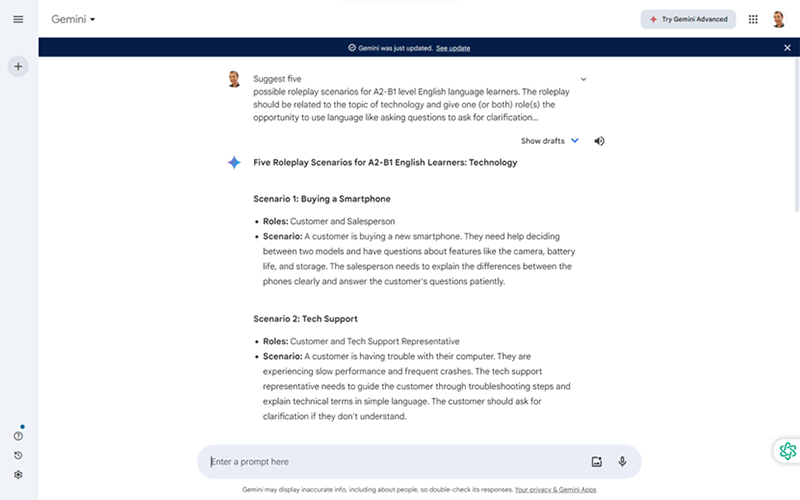
If you are teaching business English or English for specific purposes, you might want to give more information about the learners. Alternatively, get an AI text generator to ask you questions until it has enough information about the students to suggest roleplay scenarios.
Prompt: I want you to suggest some English scenarios for my language students. The roleplay scenarios must relate to the students’ background, context and the topic of my lesson. Ask me questions, one-by-one, until you have enough information to suggest several roleplay scenarios.
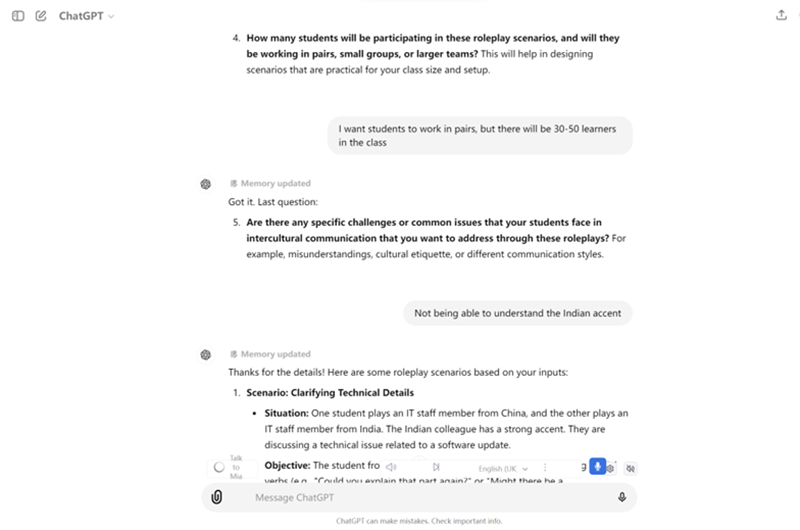
These scenarios, with a bit of tweaking, can inform the next step – creating role cards.
Creating Role Cards
Role cards explain to students who they are going to be during the roleplay. What are their goals for the conversation and what are their motivations?
Writing role cards is tricky. These need to explain complex information in simple, easy to understand English. If your students are at B1 level, write your role cards at A2. If your students are B2, write the role cards at B1.
Each role needs its own card. Role cards create some understanding between the students. They should introduce the background to the conversation. But role cards also need to spark conflict between the speakers. Conflict can come from competing goals. One student might have a goal of finishing a conversation quickly, while another wants to talk for as long as possible. One role might need to ask for a favor, while the other has to avoid accepting. Hiding information from one of the learners can also create conflicts. One of the students might be told about just one side of a problem, caused by the other role, remaining ignorant of how they helped to cause this issue. Unshared information and competing goals mirror the misunderstandings and incomplete information that are part of most real-world interactions.
Prompt: Create role cards for two [CEFR] level learners on the scenario: [your scenario] ### The role cards must use simple, easy to understand English. Each role card must include an information gap. This must be information that one speaker knows but the other does not. This will encourage the students to communicate with each other and create some conflict between the two speakers. Do not indicate in the role cards which information is part of the information gap. The roleplay should encourage one or both learners [description of target language or skills or aim of lesson].
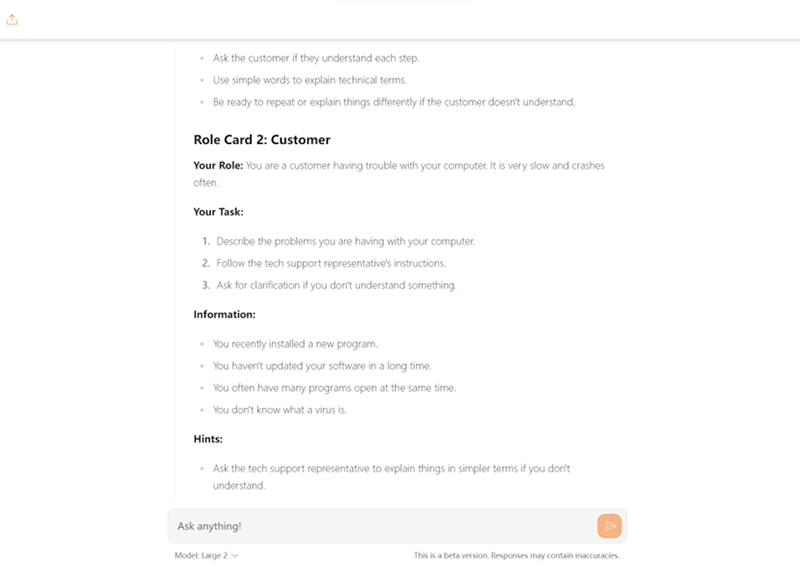
Using Examples
AI often does best when shown examples. If you have role cards that worked before, use these to create more. Ask AI to analyse the cards. This will focus the AI on the right areas when creating new cards. Then give the AI the background to new roleplay.
Prompt: Please read these role cards for roleplays in [type/description] English classes. Summarise how these would encourage students to negotiate or be in conflict with each other. Next, create five new sets of role cards on [topics]. Each role card should:
- be detailed and include at least 4-5 sentences in simple [CEFR] level English.
- include some 'hidden' information that the other roles are unaware of. Do not indicate what information is hidden on the role card.
- include enough information that each student should be able to understand their role, their goal for the conversation and the background to the conversation from reading their card only.
Role cards: ### [existing role cards]
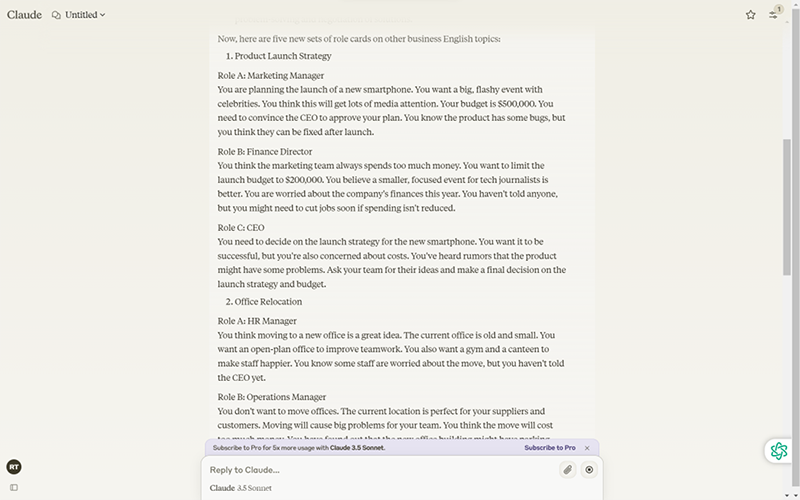
Personalising Roleplays with AI
If you teach English with a group of learning with specific needs, AI can personalize your roleplay materials. Imagine that you have a roleplay planned for a group of learners who work in the IT department of a bank. Tell an AI about their background and ask it to tweak the roleplay so that it fits the learners’ work context.
Prompt: Look at the roleplay below. This will be used by students in [details of the context]. Tweak the roles so that these better match the context of the learners. Role cards: ### [Role cards]
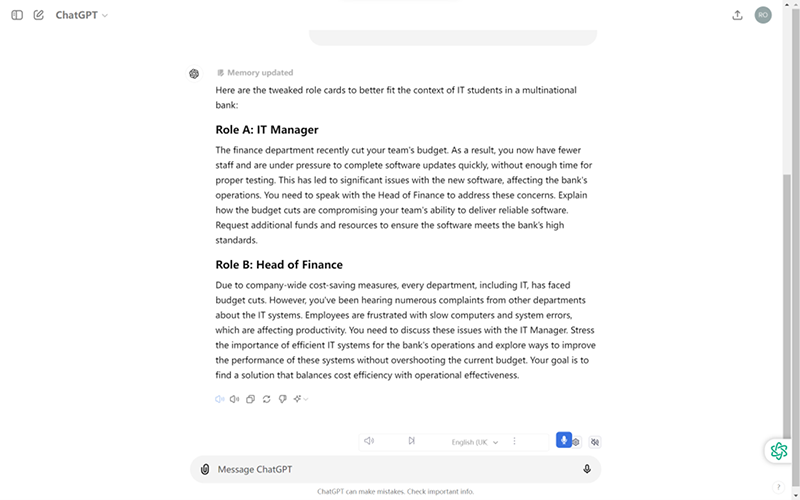
Roleplaying with AI
Until now, we’ve been talking about roleplays between students, with materials made using AI. But AI can also roleplay with students. This is especially useful when learners don’t have anyone else to talk to, such as in one-to-one lessons or as part of homework.
We need to be especially careful planning prompts for AI roleplays. If these are part of homework, you won’t be there to tweak the prompt if there are any issues. You’ll need to write detailed prompts and try these out before giving them to your students. AI isn’t a mind reader. Without specific instruction it might be too cooperative, leading to a short, uninteresting roleplay. Or AI might also use complex language which your students can’t understand. To get AI roleplaying, we set parameters. These are similar to the information students get from reading a role card. AI needs to be told for example:
- Who it is.
- What their goals are for the conversation.
- Information (something the AI knows but the student does not)
- The level of language they should use.
- The age of the learner they will talk to (important so the AI keeps the conversation to an appropriate cognitive level).
- Bringing these together in a prompt, we get something like the following:
Prompt: I want you to do a roleplay with me. You are a [role]. In the conversation you must [description of the goal]. You will interact with an [age] English language learner at [CEFR] level. You know/think that [information gap].
We could give students a complimentary role card. Here is an example:
AI Prompt: I want you to do a roleplay with me. You are a policeman. In the conversation you must find out what the suspect did last night between 8 and 10pm. You will interact with an adult English language learner at B1 level. You know that they were seen last night at 9pm near the crime scene by the River Amond. You think that they pushed an old lady into the river and stole her handbag.
Student role card: Last night you and your friend were walking by the river when you were meant to be at work. You told your boss you were ill. If anyone asks, tell them you were at home last night. Last night you saw an old lady fall into the river. You tried to help her but couldn’t.
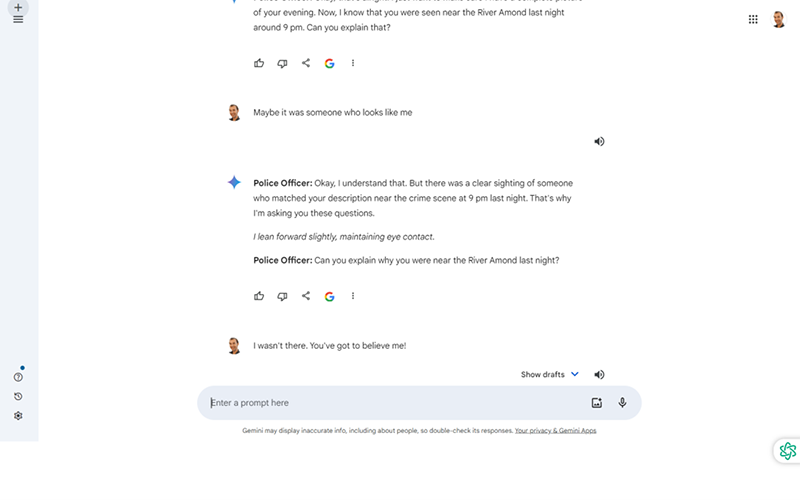
The problem with a roleplay like this is that students see the prompt when starting the conversation, removing suspense and surprise. To solve this, create your own chatbot or GPT for students to roleplay with. This is much easier than it sounds.
Poe allows users to create their own bots (for free). Using the prompt and role card from earlier, we can create our own roleplay bot.

After saving the bot, send a link to the to the students. As students go through the roleplay, they will learn more about who they are talking to and why. These make for fun homework. They can also be done in class, with students working together to decide what to do next.

After doing a roleplay with AI, students can ask the AI for feedback on their use of English, how they interacted or even repeat the roleplay, trying to get a better outcome.
These roleplays could be turned into speaking and listening exercises by altering the input and output on the AI. ChatGPT, Gemini, Groq and Poe all accept audio input, allowing learners to speak instead of type. ChatGPT and Gemini can ‘talk’, allowing students to listen as well as read. But there’s nothing wrong with students interacting with AI by typing. This is a great way to practice instant messaging - a common writing context, rarely practiced in language class.
Advanced AI Roleplay Tips
The AI roleplaying prompts we’ve looked at so far are quite short. Roleplaying prompts can however extend to several thousand words (here for example). If you have more time to craft longer prompts, consider the following tips.
- Break the roleplay down into steps. Tell the AI what to do at different stages. For example, step one might ask the AI to introduce the scenario. The final step could involve giving feedback.
- Tell the AI what not to do, as well as what to do. Instructions for what to avoid can be included as part of each step.
- Set limits for how long the roleplay should last. Tell the AI that after a certain number of turns it should push the student to make a decision and finish the roleplay. Equally important is making sure that the roleplay isn’t too short. You could instruct the AI, “Do not end the roleplay too quickly. It is okay if the roleplay does not reach a successful conclusion”.
- Allow for feedback. Specify what feedback the AI should give after the conversation finishes. You might ask the AI to give feedback on vocabulary, grammar, spelling, etc. as well as suggestions on politeness, negotiation or even creating rapport.
Limitations
Hopefully you’re now as excited as I am about using AI to prepare and conduct your roleplays. However, it's important to recognise some limitations. Let’s start with conducting roleplays. AI can’t see. That means it won’t notice any body language. It also can’t hear, at least not in the way that you and I can. Intonation, crucial for real-world speaking, won’t be acknowledged. AI isn’t great at grading it’s language, which can make AI roleplays difficult for students to understand, even if you’ve specified CEFR levels in prompts. As always, privacy is worth talking about. Make sure students know not to share private information during roleplays with AI. Give students who might not be able to access AI a non-AI alternative for any roleplays. And of course, avoid using AI too much. Your students need to talk to each other more than they need to speak to a chatbot.
Using AI to create roleplay materials is a little less problematic, although the usual limitations apply. AI might not understand what you’re asking it to do, or might simply suggest bad ideas. Make sure you read whatever materials AI writes before showing them to students. If you want to check that the role cards are at the right level, use a readability checker like Hemmingway Editor or Oxford’s Text Checker. These will highlight sentences and words (respectively) that might be hard for students to understand.
Conclusions
AI offers us exciting possibilities in both preparing and running roleplays. AI can generate scenarios, create role cards, personalise roleplays, and even serve as a conversation partner. It can save time when planning, provide more tailored practice, and take roleplays beyond the classroom and as part of homework. In spite of these benefits, AI roleplays aren’t a replacement for teachers’ expertise or pair work. Any roleplay materials created by AI need to be carefully checked before students see them. Although interacting with AI can be fun, learners need to interact with other humans much more than with AI.



